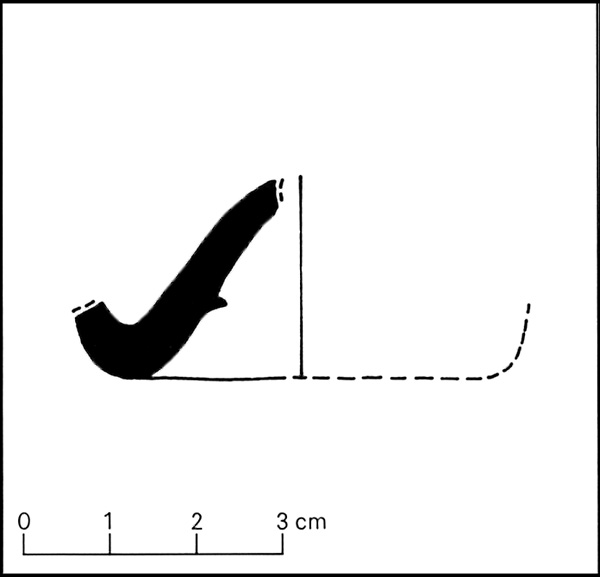Canadian Historic Sites: Occasional Papers in Archaeology and History No. 10
Glassware Excavated at Fort Gaspereau, New Brunswick
by Jane E. Harris
Artifacts from the English Occupation
Wine and Spirits Bottles
English glass artifacts recovered from the fort are mainly limited to
wine bottle fragments. There were 28 of these fragments found, most of
which were excavated from the areas of the commandant's quarters and the
southwest bastion, while the remainder came from the proposed barracks,
the northeast bastion and the south palisade and ditch trench. Due to
the fragmentary condition of the bottles it is difficult to determine
their exact number; however, there are at least 10 and possibly as many
as 25 bottles represented.
One bottle is represented by an almost complete olive green (5Y) body
and base (Fig. 12). The glass is in very good condition with a glossy
surface and no patina. The body is cylindrical and wide in relation to
its height: 117 mm. in diameter, 90 mm. high, and has a distinct basal
sag. The base is also 117 mm. in diameter with a dome-shaped push-up 31
mm. high. The push-up bears a light sand pontil mark 60 mm. in diameter
and a small, irregular mamelon at the tip 5 mm. in diameter. The
presence of a mamelon on a bottle of this period is an unusual feature
as they are not commonly found on bottle bases before the 1800s.

12 Almost complete English wine bottle, illustrating scratched
initials "JC" and the mamelon at the tip of the push-up (1E3C6-2).
|
In NoŽl Hume's (1961: 104) wine bottle typology, bottles of this type
date to 1740-60, an intermediate stage in the evolution of the tall
cylindrical wine bottle. These dates are supported by Renťe Marwitt
(1966) who reports bottles like the above found at the Fortress of Louisbourg
in a probable archaeological context of 1754, and Rees Price
(1908: Fig. 7, facing p. 124) illustrates a sealed wine bottle of the
same form bearing the date 1755.
A curious feature of this bottle is the set of initials "JC" crudely
scratched on the body. The same initials have been found scratched on a
wine or spirits bottle from Fort Beausejour. Although the two forts are
less than 20 miles apart the dates of the bottles differ considerably.
The Beausejour bottle is tall and cylindrical, and probably dates from
the late 18th century or even the early 19th century (NoŽl Hume 1961:
103). These bottles might have belonged to the same person or
family.
A second bottle is represented by a complete neck (Fig. 13) of olive
green (7.5Y) lightly patinated glass. The neck is tapered, 24 mm. in
diameter below the finish, 33 mm. at its mid-point, and 46 mm. at its
base. It is 80 mm. high including the 11 mm. high finish. The finish
consists of an everted lip 3.5 mm. to 5 mm. in height and 28 mm. to 30
mm. in diameter, and an applied, down-tooled string rim 5 mm. to 7 mm.
high and 34 mm. in diameter. On the whole the neck is well made although
slightly asymmetrical about the finish.

13 English wine bottle neck (1E2D1-5).
|
Again according to NoŽl Hume's typology (1961:104), this type of neck
and finish is common to 1740-60 and would originally have come from a
bottle similar to the initialed bottle described above.
Nine other finish fragments were found and all have the same form and
colour as the neck described above. The lip heights vary from 3 mm. to 6
mm.; string rim heights from 5 mm. to 8 mm.
Thirteen push-up fragments exhibit characteristics which distinguish
them from French bottle bases. All of the fragments are of thick, dark
olive green glass varying from 2.5GY to 2.5Y, eight being 7.5Y. The
fragments appear to be from bases similar in size and shape to the base
in Figure 12. The push-ups are wide and rounded with evidence of sand
pontil marks. The base diameters, which could only be taken
approximately, fell between 100 mm. and 120 mm. These features are
indicative of English rather than French manufacture.
There is, however, one base fragment of olive green (7.5Y) glass from
a very mixed unit in the west palisade and ditch trench which has a much
smaller base diameter. This specimen has a glossy, orange-peel textured
surface and a cylindrical body, a pronounced basal sag and a base
diameter of approximately 90 mm. The smaller diameter and more
pronounced basal sag suggest the bottle was tall and slim giving it a
manufacturing date of 1770-1800 (NoŽl Hume 1961: 105), although this
date is not consistent with the occupation dates of the fort.
Pharmaceutical Bottles
Pharmaceuticals were small, mouth blown bottles or phials which had a
cylindrical body; short, cylindrical neck, and a flanged lip. Their
bases were usually conical or slightly domed. They were often "bottle"
or emerald green in colour and were common during the first half of the
18th century. Although in many cases the body shape remained the same
these bottles were manufactured in clear lead glass after mid-century
(NoŽl Hume 1969: 42-43) due to restrictions imposed by the government on
green glass bottle manufacturers prohibiting them from manufacturing
bottles of less than a six-ounce capacity (Wyatt 1966: 9).
Only one possible example of this bottle type was recovered, a base
fragment from the southwest bastion (Fig. 14). The glass is medium green
(10G), bubbled and slightly patinated. The conical push-up is 18 mm.
high and bears a glass-tipped or ring-shaped pontil mark 21 mm. in
diameter. The base is approximately 50 mm. in diameter with a wide,
rounded heel. There are signs of wear on the bearing surface.

14 Base fragment of a pharmaceutical bottle (1E2L1-13).
|
|

